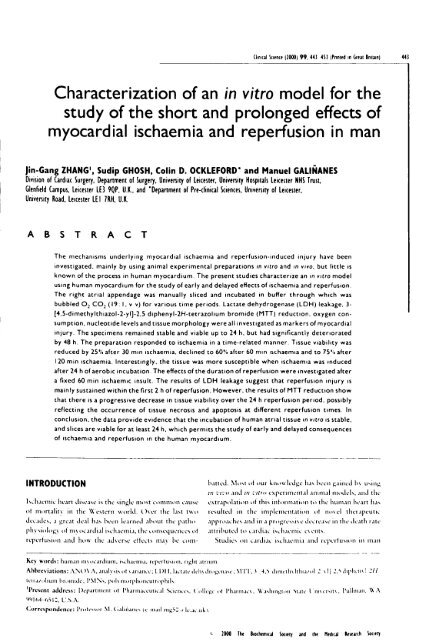ischaemic preconditioning of the human heart. - Leicester Research ...
ischaemic preconditioning of the human heart. - Leicester Research ...
ischaemic preconditioning of the human heart. - Leicester Research ...
Create successful ePaper yourself
Turn your PDF publications into a flip-book with our unique Google optimized e-Paper software.
Chni(ad Suence 12000) 99.443 4S3 (Pininted in Great Britain) 443<br />
Characterization <strong>of</strong> an in vitro model for <strong>the</strong><br />
study <strong>of</strong> <strong>the</strong> short and prolonged effects <strong>of</strong><br />
myocardial ischaernia and reperfusion in man<br />
lin-Gang ZHANG', Sudip GHOSH, Colin D. OCKLEFORD* and Manuel GALIRANES<br />
Division <strong>of</strong> (ardiac Surgery, Department <strong>of</strong> Surgery. University <strong>of</strong> <strong>Leicester</strong>. University Hospitals <strong>Leicester</strong> NHS Trust,<br />
Glenfield (ampus, <strong>Leicester</strong> LE3 9QP, U. K., and *Department <strong>of</strong> Pre-clini(al Sciences, University <strong>of</strong> <strong>Leicester</strong>,<br />
University Road, <strong>Leicester</strong> LEI 7RH. U. K.<br />
ABSTRACT<br />
The mechanisms underlying myocardial ischaerma and reperfusion-induced injury<br />
have been<br />
investigated. mainly by using animal experimental preparations in vitro and in vivo. but little is<br />
known <strong>of</strong> <strong>the</strong> process in <strong>human</strong> myocardium. The present studies characterize an in vitro model<br />
using <strong>human</strong> myocardium for <strong>the</strong> study <strong>of</strong> early and delayed effects <strong>of</strong> ischaernia and reperfusion.<br />
The right atrial appendage was manually sliced and incubated in buffer through which was<br />
bubbled 02 C02 (19 ý11v v) for various time periods. Lactate dehydrogenase (LDH) leakage, 3-<br />
[4,5-dimethylthiazol-2-yi]-2.5 diphenyl-2H-tetrazolium bromide (MTT) reduction. oxygen con-<br />
sumption, nucleotide levels and tissue morphology were all investigated as markers <strong>of</strong> myocardial<br />
injury. The specimens remained stable and viable up to 24 h. but had significantly deteriorated<br />
by 48 h. The preparation responded to ischaernia in a time-related manner. Tissue viability was<br />
reduced by 25% after 30 min ischaernia, declined to 60% after 60 min ischaernia and to 75'14 after<br />
120 min ischaernia. Interestingly, <strong>the</strong> tissue was more susceptible when ischaernia was induced<br />
after 24 h <strong>of</strong> aerobic incubation. The effects <strong>of</strong> <strong>the</strong> duration <strong>of</strong> reperfusion were investigated after<br />
a fixed 60 min ischaernic insult. The results <strong>of</strong> LDH leakage suggest that reperfusion injury is<br />
mainly sustained within <strong>the</strong> first 2h <strong>of</strong> reperfusion. However, <strong>the</strong> results <strong>of</strong> MTT reduction show<br />
that <strong>the</strong>re is a progressive decrease in tissue viability over <strong>the</strong> 24 h reperfusion period. possibly<br />
reflecting <strong>the</strong> occurrence <strong>of</strong> tissue necrosis and apoptosis at different reperfusion times. In<br />
conclusion, <strong>the</strong> data provide evidence that <strong>the</strong> incubation <strong>of</strong> <strong>human</strong> atrial tissue in vitro is stable,<br />
and slices are viable for at least 24 h, which permits <strong>the</strong> study <strong>of</strong> early and delayed consequences<br />
<strong>of</strong> ischaernia and reperfusion in <strong>the</strong> <strong>human</strong> myocardium.<br />
INTRODUCTION<br />
Isdiacmic licart disease is <strong>the</strong> singic most common cau%c<br />
<strong>of</strong> mortallt, N In thc Wc%tern world. ()%cr <strong>the</strong> last two<br />
decadcs, .1 grc. it deal ha% becii Icarned about <strong>the</strong> patho<br />
1111%<br />
%iology ot m. %<br />
ocardial ischacniia, dic t: on%cqucncc% <strong>of</strong><br />
repert . uslon and how <strong>the</strong> ad%crsc ctfccts may bc com-<br />
Kcý words: liuman imocardium, i%tAmcnim, rclicitusimi, tight Itfllllll.<br />
haticd. Most <strong>of</strong> out knowledge ha,, bccn gamcd I, \ ii, ing<br />
in and in zvoo exilcrinictital animal motick, and flic<br />
cxtrapolation <strong>of</strong> this infoi mation to <strong>the</strong> <strong>human</strong> licart li, i%<br />
tc%ultcki in <strong>the</strong> inipIcnictitation ot no\cl diciapctink<br />
appi oac lics and 1na piogrcssi\ c dcc i casc in i lit, kicat h ratc<br />
attributcd it, catkilac 1"'Alacink C\Clltl,.<br />
Studies on cardia,: i%ducinia and rcpcitusion in nian<br />
Abbrc%-iations: ANM A, anal. N sis ot %artaiwc, I. D1 1, la,: t au: d ch% d iogctia%cý NVIT, 3 4,5 Lf I 111C111% I III [A/0]-' %I i 2, S diplicm ! 211<br />
ima/Aium biomide; PMN%, pok morphoncutrophils.<br />
Tresent<br />
address: Department ot PharflIal: CIJIWAI SIAMIA-1, ( ý1111L-gc ot Pliamia,: % , \\ admigion Statc I<br />
99164-(, 51^,, U. S. A.<br />
Pullman, \\A<br />
Correspondence: hotc-m M. GaIiiianc, (c mad ings',<br />
c<br />
2000 The Boochemi(al sooety and <strong>the</strong> Medi(al Reseaf(h so<strong>of</strong>ty














